Leave for Change Blogs
Many Leave for Change participants blog - often before, during, and after their volunteer assignment - capturing the diversity and richness of their volunteer experience, their reactions to being in a new country, how they navigate and negotiate their mandates, and the impact the whole experience has on them personally and professionally.
You can search blogs by person, country, or year. Enjoy!
Back to School for College Students in Ho Chi Minh City
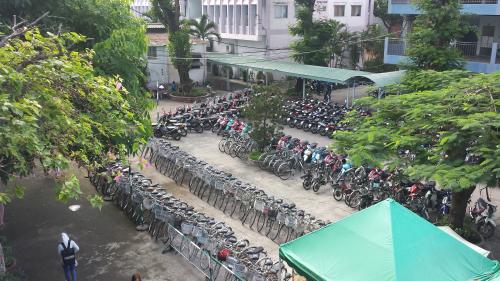
Scooters and bicycles lined up in the courtyard means back to school here, Monday August 3. A new term has begun today for some 3,500 students enrolled at Ho Chi Minh City College of Economics (HCE).
Entering my fourth and final week in Vietnam. I'm working on a Leave for Change assignment for Uniterra, an international development organization in Canada. You use vacation time to volunteer to work in a developing country.
I'm helping with marketing communications here at HCE and at Saigontourist Hospitality College here in town. Presenting workshops about interviewing, writing, content management to college teachers and admins in both places. Also helping with writing of text and scripts for school promo videos being shot here by Jeff Winch, another Uniterra volunteer and a media and photography instructor at Humber College.
We're working with a core of about four teachers and admins here on these projects. Workshop participants involve some 20 people. Working through a translator, so sessions require more time and flexibility. Also need to exercise personal flexibility and patience: turns out schoolteachers themselves -- here at least, maybe also in Canada -- dislike doing homework assignments.
Just returned to Ho Chi Minh City early this morning from a weekend train trek to Nha Trang on the east coast of Vietnam. Didn't take my laptop on that journey. Some posts to share here from the weekend: will do soon.
Two Uncle Ho Faux Pas in Two Weeks
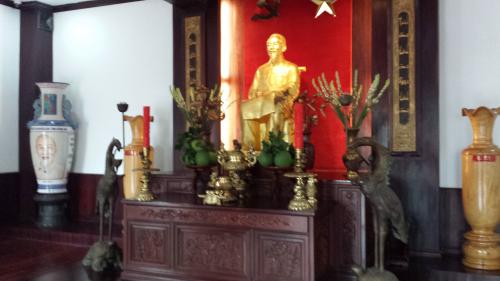
Ho Chi Minh keeps getting me into trouble.
Here in his namesake city, you can't go far without running across Vietnam's father figure. Make that uncle figure. Uncle Ho -- his nickname is a sign of affection rather than disrespect -- smiles at you everywhere: from billboards, banners, currency.
He's commemorated in a number of places around this city of 13 million souls. One is a namesake museum in the port district. The building, known as the Dragon House, was built by the French in 1863 as the former custom house.
Ho was just 21 when he embarked from here in 1911 on a voyage to France, the Soviet Union, China and the United States that ended up lasting some 30 years. He spent much of that time trying to rally support for Vietnamese independence from the French colonists. When he returned to his homeland, he led the Viet Minh war that overthrew the French in 1954. He died in 1969.
I toured around the old custom house one grey morning.
Place is full of photos and captions of his life and times. Pictures show him speaking at political and labour gatherings. Meeting foreign dignitaries. Visiting a hospital, an air force unit, teens and farmers.
Outside is a white Peugeot presented to him as a gift.
And my trouble?
A couple of weeks ago, I drew official whistles from guards at another Uncle Ho shrine: his larger than life statue located in the plaza fronting the People's Committee building (another former French edifice). That time, I had gotten too close with my camera.
Now in the museum I had my camera out again, this time to catch the statue and shrine picured above. No whistle this time, but a guard motioned me back. I had neglected to remove my shoes at the room entrance.
That's two strikes. We have a week and a biit left here in Uncle Ho's city before we head back to Canada. Looking to avoid a third strike before that...
DIY Dinner Brings Surprise to the Table
No photo with this post but maybe better to imagine it for yourself...
We visited a new restaurant the other night. "We" are myself and Jeff Winch, media and film instructor at Humber College who is also on assignment for Uniterra here in southern Vietnam. Both working at the Ho Chi Minh City College of Economics. He's helping produce film for the school. I'm working on marketing and promotional materials.
We found a seafood place. I'm not big on seafood, but as Jeff likes to say, it's an adventure.
Like many places here, this restaurant's size is deceiving. Small street frontage but inside it opens up into a cafeteria-size space, high ceilings. Din of voices. Rows of tables. And stacked rows of fish tanks along the walls, all bubbling away. Elsewhere, aquariums are just part of the ambience of a place. Here they contain dinner.
Before now, we've found eating places where the menu has English subtitles, even if not quite correct English. Our favourite last week -- not the entree itself but the menu listing -- was the sign announcing the daily feature: "Penis and ball of goat with medicinal herbs."
And usually the wait staff are able to help us figure things out. Tonight it was all Vietnamese.
We thought we made out a picture of shrimp on the menu. Still, we weren't sure whether the waiter was playing back shrimp or squid. And why was he offering chicken feet? At least, that's what we thought he was offering, although it made no sense in a seafood place. Having asked for shrimp and rice with greens, we sat back with our beers, listened to the rain battering at the galvanized roof and waited to see what came...
It didn't take long: it never does here.
The server brought us cooked shrimps all right. But then she brought another plate. Jeff and I looked at each other and back at the plate. Big shrimp this time: six of them. Each about as long as a pen. And still with appendages waving. Kind of slipping around on the plate. Well.
Along with the shrimp came a stainless steel hot pot. Popular thing for the table here. DIY dinner. Unless you're foreigners who need help. The server lingered throughout the meal to help.
She slipped what looked like a fat paraffin candle into a separate pot, then placed the cooking pot on top. Waited for it to boil. Opening the lid, Jeff said, There's something in there. Some kind of soup.
A few minutes later, the server emptied the plate's occupants into the pot, replaced the lid, let it all simmer for a few minutes. Threw in handfuls of greens for just a minute, the way you do broccoli or asparagus here.
She fished out the shrimp -- now reddened and still -- on a plate between us. Ladled the soup and greens into bowls along with fine noodles like spaghettini. Never did see any rice: maybe they were rice noodles.
I had a couple of the shrimp but they were a bit rich for me. Stuck mostly to soup and greens, all nice and spicey as so much of the food is here. Jeff ate the lot.
Late Friday we're booked on the overnight train to Nga Trang, a beach place on the South China Sea. An eight-hour trek from Saigon Railway Station. Will get there early Saturday morning, stay overnight and catch the overnighter back to Ho Chi Minh City on Sunday, arrivng early-early Monday morning.
I expect this beach place will feature plenty of seafood. Will look for something a little less DIY than the other night.
It's an adventure.
Vietnam: An Old Land Brimming With Young People
Two out of three people here in Vietnam were born after 1975.
Read that again. Slowly.
A young country, this. 1975 was the year that Saigon fell to the North Vietnamese and communism came to the south. Today a huge gap separates those born before the Vietnam War from the majority -- those with no personal recollection of that conflict.
Today in my Guelph Mercury column (From the Second Storey), I write about one witness to the war years here -- and how Hoang Don Nhat Tan links his experience to that growing younger generation.
Is It Safe to Walk Around Saigon After Dark?
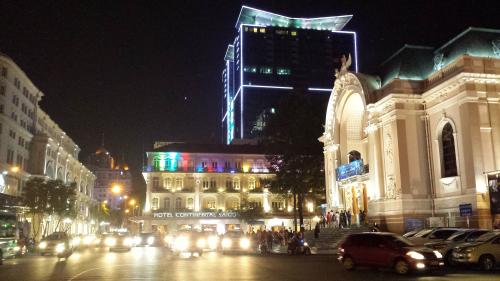
Someone at home in Canada asked whether it's safe to walk around after dark in Ho Chi Minh City. Yes, is the short answer.
I've been out after dark in the city every evening since we arrived 2 1/2 weeks ago. Staying in District 1, which is the tourist haven and arguably the most secure. But a couple of times, I have lingered after work at Ho Chi Minh City College of Economics, which is in District 10.
By taxi, it's about 15 minutes between college and hotel. On foot, about an hour. A couple of times, I have walked all the way after dark. Scary? No.
First, there are always lots of people around, People spend much of their time outdoors here.
The sidewalks are like front patios or porches for many people. But business patios, not leisure patios. Everyone is out front, selling what they're selling. Food mostly, it seems, but just about anything. For entire city blocks, you walk past what look like North American-size garage openings, each side by side in one long row. Each one contains a business: could be anything and pretty much is: a hair salon, a photocopy place, a scooter rental place, a restaurant, carpets, furniture, another restaurant, a bar, a coffee shop, another restaurant, another scooter rental. Closely packed businesses like multiple Main Streets stretching for entire city blocks -- and not just on the main roads but on many of the side streets, too.
Those businesses stay open late. Not sure what time they pull the grilles down or across, but anytime I've been out after dark, they're all open. And they're all occupied with owners and patrons, someimes just sitting around but they're there. Inside and outside kind of spill into each other.
That means it feels safe just beause there are so many people around. Not to mention the non-stop traffic. Scooters forever passing within feet of the sidewalk. You might see all those people as just so many purse-snatchers, but it feels like the opposite: just so many eyes and ears aware of each other.
One night early on, I walked for what seemed like forever, aiming for the hotel. Realized I'd overshot so had to find my way. Asked a security guard outside a hotel. Ten minutes that way, he said. Sure enough, 10 minutes later, I recognized where I was. By the way, many security guards around here, not just at hotels but other places: scooter dealerships, bookstores. Seems they're more worried here about shoplifting than about mugging.
Many of those people smile -- even after dark. It's like walking around downtown Guelph, honestly, with traffic mayhem -- and without the sketchy bar scene on Wyndham and Macdonell.
One Saturday afternoon I was on a long walk on a busy street in unfamiliar territory. A guy called out to me from behind. I turned to see him pointing at something on the sidewalk. I'd dropped a bill. Not much money but still...
Another day, someone pointed out that I had set my phone down on a chair while attending to something else. He had no English, this fellow, but vigorous pantomiming made his message clear. Don't leave your valuables sitting around where someone might snatch and run. Far from looking to mug you, people remind you to be careful. Not just after dark but in the daylight. Kind of the way you would pay attention to yourself and your belongings in, I don't know, Toronto, Montreal... There are more sketchy areas in this city, I'm sure, but common sense tells you where to go or not.
So, yes, safe in Saigon, at night or in the day...
Heat, Rain in Saigon? Two Weather Myths
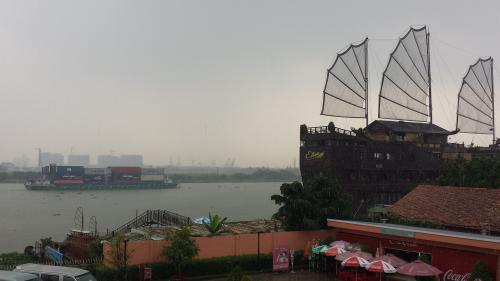
Today's Guelph Mercury says there's a heat wave in town. Imagine what it must be like here in southern Vietnam. You might be surprised.
I looked at the Guelph weather today. Says it's around 30 with humidity.
Weather concerns have turned out to be a bit of a myth here in Ho Chi Minh City. Today -- Thursday -- it's supposed to be about 33 with humidity around 83 per cent. That's been pretty much the story every day here since mid-July. The highest daytime temp has been 35. Nights, the temperature drops to about 26 (granted, I'm staying in an AC'd hotel).
Even up in Hanoi in the north, where I'm told things can get hotter, it's been the same story.
I had expected to be uncomfortably sticky here. 33 degrees and 85 per cent humidity might be offputting to some. I'm kind of indifferent to weather -- cold, hot, humid, rain, sun -- so maybe it's me. A few times I've found myself wringing wet. But that's because I've chosen to take a long trek on foot, sometimes with a full backpack of stuff. Otherwise it's been comfortable -- kinda like summer at home, I say to folks, maybe in a bit of a heat wave.
Ah, Southern Ontario. Ah, Saigon...
Speaking of myths, I was also warned about the rainy season here in southern Vietnam. That's happening right now. I had imagined days of rain on end. Maybe even monsoons...
There are two seasons here in the south. Up north, they have four seasons more like ours at home. (Someone said one spot north of Hanoi gets snow.)
Here, Saigon gets a rainy season and a sunny season.
Rainy season is June through November -- so right now. But rather than constant rain, what you get is a downpour at some point on most days. The heat builds through the day and then everything breaks open for about an hour or so. Sometimes it's torrential. The other night at dinner, a thousand people started pounding on the roof -- or that's what it sounded like. By the time we left the restaurant, the rain had stopped.
Yesterday morning it rained. The photo above shows the grey over the Saigon River, maybe you can make out the rain. Again, about an hour or two, then it cleared for the rest of the day. Par for the course this month: that's the rainy season.
They say the sunny season -- December through May -- brings hardly any rain at all and temps up around 40 by April. Lows of 20 in December.
There's been plenty of sun here in this rainy season. Solutions for heat here include smoothies and fruit drinks, just about anywhere. Here'spart of the crowd from the college where I'm working, all at the Ben Thanh market downtown. We were out for a photo, video shoot for promo materials for the Ho Chi Minh City College of Economics (media guy Jeff Winch from Canada is in the middle of first photo below). Having freshly made sugar cane juice (a bit of lemon juice thrown in).
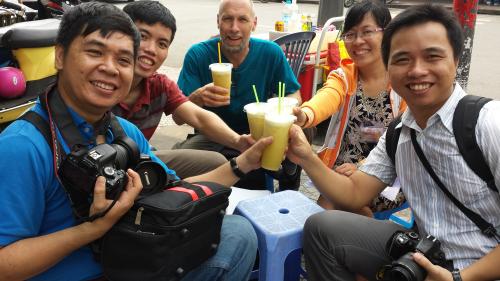
How fresh, you ask? The market vendor grinds the sugar cane right there...
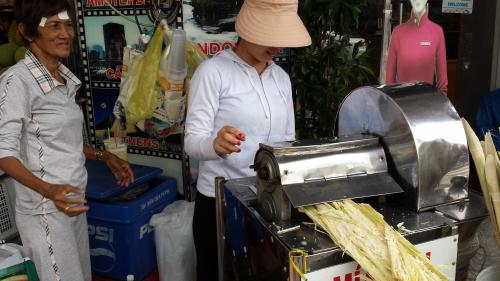
Graduation Ceremony at Saigontourist Hospitality College
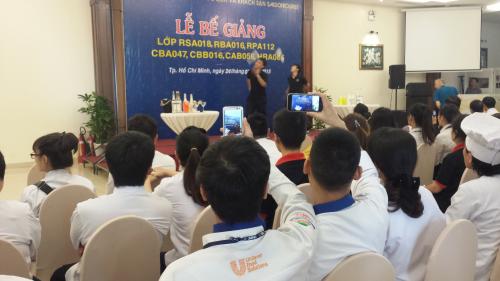
Graduation ceremony for students in certificate programs at Saigontourist Hospitality College late last week. About 100 students graduated today, some having studied while working in the industry. Certificate students spend two to four months learning specific skills: bartending, cooking, baking, housekeeping.
Pre-graduation entertainment consisted of two STHC staffers demonstrating juggling of cups, bottles and other bartending items. Well, flaming torches are not standard bartending tools but they did, er, light up the room.
Part of my Leave for Change assignment here involves working with the college to assess promotional materials including their website and to suggest improvements. Also including them in a couple of workshops about interviewing and writing skills.
Also met Mr. Tan here, a lifelong Ho Chi Minh resident and STHC staff member whose story will form part of this week's From the Second Storey column in the Guelph Mercury. Look for that here Thursday.
Final day - where did the time go?
It's my last day here in Kathmandu and 4 weeks has flown by!
Here's what I've been up to:
- Agriculture in Nepal has long been based on subsistence farming, particularly in the hilly regions where families derive their living from the land, sometimes extremely hilly terrain, where terraces or shelves of workable land have been established over hundreds of years.
- Over 80% of Nepalis are involved in agriculture and dairy farming makes up 12 % of the gross domestic product.
- Recent encouragement to expand to commercial farming, milking as few as 5 cows or buffalos instead of 1 or 2 for the family, has inspired many farmers. However, fodder production for these animals can be a challenge, especially in the hilly regions, where grasses are not easily found, and tree leaves have been incorporated into the diet of the animals.
- Monsoon season, which is June - September annually, dumps an average of 100 - 360 mm of rain each month, but in the winter or dry season, only 10 - 20 mm falls monthly. This leads to a lack of fresh water, both for the animals and dairy milk processes for a good portion of the year. The supply of electricity also fluctuates as production is through hydro-electric dams.
- Hilly and mountainous regions have roads that are described on maps as "highways, other motorable roads and major foot trails". The roads are prone to washes from rain, landslides and many hug the mountainside as a single lane only. Farmers deliver their milk to collection centres, travelling several kilometers on foot, by bike or motorbike, in metal or plastic milk cans, sometimes pails and jugs.
- In some areas, it's a challenge to collect milk twice a day, and so once daily collection occurs, which means that the evening milk can reach ambient temperatures and there are delays until the milk reaches a chilling vat.
- There are 78 districts across Nepal, and 1800 Cooperative groups - collective groups organized for dairy farmers - are established in 64 districts.
My work with the Central Dairy Cooperative Association of Nepal (CDCAN), was to assist them in developing skills for writing funding proposals. I visited two milk collection centres to view activity and develop an understanding for a comparative analysis, to assist them in developing targetted proposal writing.
Together, the Board of CDCAN and I determined that, in addition to their interests in modernizing the dairy industry through technology, the ability to improve the quality of milk in Nepal (and thus increase the financial return to the farmer) stems from training at the grass roots level. This is nothing new, as several volunteers have discovered and even developed training in specific districts in the past. As the national umbrella organization, CDCAN focuses on policy development and activities promoting advocacy in support of dairy cooperatives, including:
- Commercialization of dairy farms
- Educating farmers / dairy cooperatives
- Treatment of animal for diseases
- Promoting the use of high quality semen for optimum production
- Advocating for appropriate fixed prices of milk
This is the first time that CDCAN has hosted a volunteer and through several training sessions and board meetings the new leadership and management, they are now planning to develop online methods to disseminate information, training and materials to the Districts, for sharing with farmers, nationally. So much foundational work has been done by others here, many Canadians and U of G volunteers - which I was able to gather together as a library for their use. I feel that in a small way, I will have helped move the future of dairy farming forward here, though the work has really just begun.
Meanwhile, the beautiful people here continue to milk their cows, grow their crops, sell their wares and raise their families along the border of the Himalayas, which are clearly visible many days. Best of luck, Nepal!
Last night I enjoyed a farewell dinner with other Canadians, and so today I pack my bags with a few souvenirs and shawls bought to stay warm, and head to the airport later today for the long way home. Such an amazing country - I hope to return, some day!
Final Days - delayed posting though
 Wow I can’t believe that I am in my last few days. The past 3 and a half weeks have gone unbelievably fast. I’ve enjoyed my daily commute with Elliot from Gaborone to Mochudi (about 40 minutes) or Phakalane (about 20 minutes depending on traffic). Whether he was navigating the cows, donkeys, goats or horses that roam either side of the highway looking for food because the rains are very late coming, or analysing the various housing options, there was always lots to discuss. Elliott is planning to build a house and has strong opinions about what he likes. I am now familiar with the many different styles of houses, roof and tile options.
Wow I can’t believe that I am in my last few days. The past 3 and a half weeks have gone unbelievably fast. I’ve enjoyed my daily commute with Elliot from Gaborone to Mochudi (about 40 minutes) or Phakalane (about 20 minutes depending on traffic). Whether he was navigating the cows, donkeys, goats or horses that roam either side of the highway looking for food because the rains are very late coming, or analysing the various housing options, there was always lots to discuss. Elliott is planning to build a house and has strong opinions about what he likes. I am now familiar with the many different styles of houses, roof and tile options.
Today is my last day at Stepping Stones in Mochudi and it is very quiet because all the kids and many of the staff are away at camp for the week. The kids were so excited and had been busy all last week practicing their skit on HIV and AIDS awareness that they will perform at the camp. Stepping Stones is a happy place and I often forget the traumas that many of these kids have experienced and live with daily. Which is exactly the goal of Stepping Stones - to allow them a chance to feel safe and happy and just be kids, at least while they are at Stepping Stones. It is a unique NGO in Botswana. Their broad based approach addresses the needs of the individual child, with life skills, education support and counselling AND they address the needs of the family or caregiver so that the child’s home life might improve as well. And they don’t stop there. They also work towards societal change with research and advocacy of issues like sexual abuse and exploitation of children. Their holistic approach is truly impressive. Stepping Stones is gaining recognition as a leader and has been instrumental in identifying and introducing to Botswana innovative programs from around the world. They are effective at establishing partnerships and are respected by funders as responsible and highly accountable. What they really need though is to secure long term funding to allow for multi-year planning.
My role here has been to work with staff helping to improve communication and conflict resolution. I have done a lot of listening and hope that I have made some impact. The feedback has been positive and several people have said already it has helped them. I think that the issues are not as big and they are not as far apart as they think. I have been impressed with how open they were all willing to be. There was a definite need for communication. Too many assumptions were being made and there was too little confidence to share. I also have tried to build on the framework that Stephanie created 6 months ago to move forward the production of the first Annual Report.
There is definitely a feeling of things winding down for the holidays both at Stepping Stones in Gaborone. I am putting the finishing touches on my reports and will debrief with Lisa tomorrow. It has been a huge honour working here but I know that I have only just begun to understand all the issues that the youth in Botswana face.
HIV AIDS and sexual abuse are two of the major issues and there are a lot of resources going towards gender base violence. On the surface, Botswana has so many positives but scratch beneath the surface just a little and you see a society struggling to find a balance with rapid growth and a break down in the family structure. There is still so much to try to understand.
It has been an honour working here and I am sad to know that the funding for WUSC in Botswana is ending. I hope that they will be able to find alternative ways to continue to bring volunteers as part of the Leave for Change program. They have the infrastructure to be able to properly support short term volunteers. My experience here has been amazing. I was asked the other day if I drank the tap water in Botswana and when I responded yes was told – well that means you’ll be back. I hope so!
Rain - really? And other unexpected situations
This is the dry season – winter. But today is a day of rain (and maybe tomorrow too). It serves to give the streets a much needed wash! The gravel side streets are muddy and I’m glad that it doesn’t rain often while I’m here.
Monkey TempleI mentioned monkeys, when we visited the Hindu temple on our first Saturday tour. Well, now and again you see monkeys climbing across building roofs or hydro wires along the roads and intersections. One evening last week several of us travelled to the so called “monkey” temple or Swayambhunath. Really, monkeys everywhere, mostly scampering and playing, sitting on ancient statues and stupas, with only few examples of squabbling – a baby sits too closely to the wrong adult, or the big male making sure the younger males know who is boss!
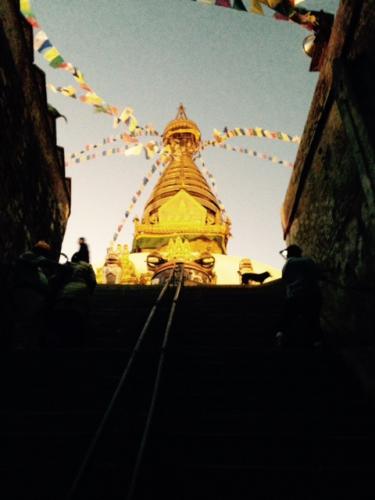
Stupa at the monkey temple
We stood still while the chase went on by. Looking down there would often be one walking within 2 feet of me! A baby monkey’s cry is rather like a kitten … very strange.
And then someone came to feed them, spreading grain onto the walkways, where easily a hundred or more monkeys waited.
 Monkeys at the temple
Monkeys at the temple
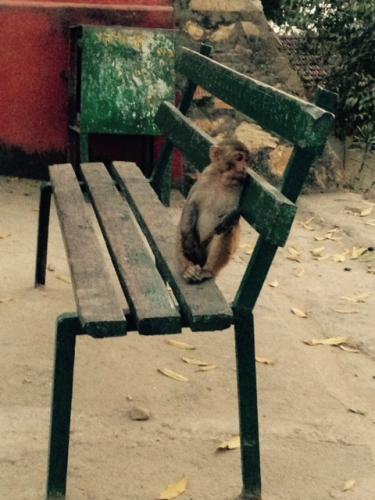
The streets are not named in Kathmandu. Only the main streets or “marg” or the major intersection or “chowk” (pronounced chalk); the rest are known for the district or major temple in the district. So I am staying in Baluwatar, or at Mayur Guest House, near Baluwatar chowk; about 1 kilometer up the road from the Bhat Bhateni chowk (Bhat Bhateni is a department store. But be careful! There are 5 of these chain stores in Kathmandu). I work in New Baneshwor (a friend works in Old Baneshwor). At my office, the staff and I had to identify our building location on the map by finding the large vegetable wholesale market next door, as none of the little streets are named.
I’ve learned to make sure I know of a store or a recognizable feature to look for as a drop off point when getting out of a cab, such as the Big Mart Store in Lazimpat, which is much more commonly known than the very amazing Jazz Upstairs pub. The locals don’t always know the name of the restaurant or store you are trying to find, so be prepared to walk a while, and phone the other volunteers for directions or to come and find you!
Fruit venders hang their wares outside their stores, so small bunches of bananas are strung up and hang as if on a fruit tree, or pineapples are attached to hooks on the walls outside. I won't post a pic of the butcher shop and what he displays!
The propane tank delivery guys scare me. They ride on bicycles, with 30 lb propane tanks hanging on each side of their rear tire, like saddle bags. Often one more is strapped sideways behind their seat, similar to how we would mount them on a forklift. And they ride along with tanks hanging right out in traffic.
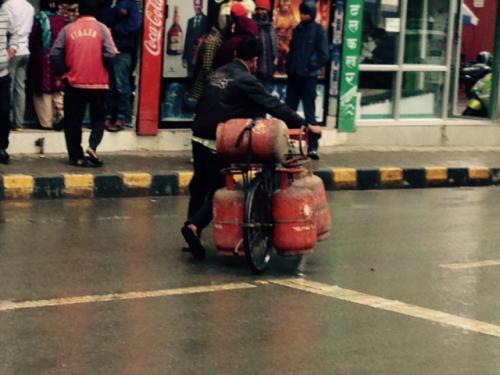 Propane Delivery
Propane Delivery
Of course, traffic here is scary anyway. Only the people in the front seat of a car wear seat belts (they don't work in most cabs anyway) and only the driver on a motorbike wears a helmet ... not the 1, 2 or even 3 passengers! Everyone edges in to where they want to go, fairly slowly but insistently and for that reason, amazingly, there seem to be few actual accidents. Maybe there are lessons to learn?
I've spent the day working on reports, as I'm sure this final week will fly by! Training sessions and meetings, a couple of dinners out planned and even a shopping trip with the office girls to another Bhat Bhateni, near Kopundol this time. Friday night and time to leave this amazing place comes all too soon!
Challenges
I’ve shared a number of my awesome experiences here, so let me share some challenges:
Load shed: it’s taking 2 full minutes (or more) to attach a picture to an email. At my office, which has no back-up generator, we work sometimes 5 – 6 hours (Monday and Tuesday are worst for my office) with no electricity and no internet (and of course, no heat in the building – though they do have propane tank heaters for inside!!). Oops! I’ve just set off the alarm by plugging in the kettle during load shed; no tea tonight but at least I have lights and internet!
Water: water is not always taken with meals; super sweet “black” tea or creamy buffalo milk tea is often enjoyed earlier or after. Sometimes lack of water is related to load shed and buckets of water are provided to “flush”. Since drinking water is not often ad lib or safe from the tap, I wonder if that (and the lack of availability, along with the logistics involved in carrying it) is sometimes the reason that it is not offered ad lib to the animals (think how that affects dairy milk production!). What an appreciation I will have for our abundance after my time here.
Dust: street dust is everywhere, which is why shoes are usually removed when entering the offices. So you are wise to bring slippers … see the point about lack of heat above! Cattle wander the streets on occasion, even young bulls. Not sure what they eat in the city. Most goats I see are tied up - outside the butcher shop!
Air quality: see dust, above. Now think cars and trucks, scooters and motor bikes, many are diesel, pretty sure there is no emissions testing, lined up, honking, squeezing past each other in a city of roughly 2 million. I have seen 4 intersections with street lights – none of them working. Police stand in the street and direct traffic. I have seen a couple of police horses, standing quietly “ground tied” with their reins looped over their withers in the middle of 6 lanes of honking mayhem! People buy cloth masks and wear them often, or hold scarves over their nose and mouth; I brought a 3M N95 respirator and I’m sure I look like I’m from Mars!
Dogs: the street dogs are everywhere; they sleep all day, often in the middle of the road (traffic goes around them on small streets) or curled up into doorways. They often bark all through the night, going about their business of maintaining their territory. They are dusty and full of bite marks. It breaks my heart to see puppies and not be able to rescue them- I miss my own dogs! People walk around them and ignore them, and they ignore people mostly. They do respond to honking cars, walking carefully along curbs and crossing safely. There are some pets here too. I’ve seen german shepherds, a boxer pup and a chihuahua at the pet store and of course, the famous pug breeder near the Passage house, where most Leave for Change volunteers stay. Feeding time is 5 am!! Oh, and streets can be messy with dog mess added to the dust.
People: the people here are amazing! Dressed in brightly coloured clothing, from an array of fashions. Ladies in silky and satiny saris under winter coats drive scooters while wearing high heeled sandals or sit sideways behind as a rider; others wear traditional long tunics over pants, and some are in modern day wear. Many are still wearing sandals at this time of year, and then barefoot indoors! It’s perfectly safe to walk alone at night here. I was lost earlier tonight in the dark after getting out of a cab a few streets early. No one bothers you. They will try to help when approached, though we don’t always understand each other. When Nepalis meet you, they invariably ask where you are from, why you are here in Nepal, and what you think of the country. They are curious, kind and sharing, make and eat amazing foods. I’m so lucky to be here and hope I'm able to make a difference.
Work and Play
Last weekend, I took a holiday of 2 days with some other girls here from Ottawa and UBC and we flew to Pokhara on Saturday morning, about a 35 minute flight. We boated across Lake Phew, past an island with a temple and climbed a mountain (the book says its a peaceful stroll -- HA!! it was a good uphill climb for an hour!) up to the Peace Tower stupa; my legs were relieved to reach the top (and wobbly by the time we returned to the bottom!).
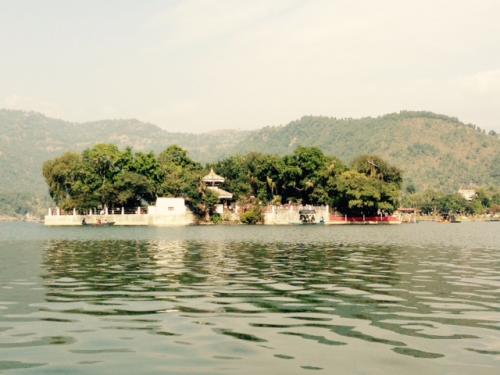 Temple we saw from the boat
Temple we saw from the boat
 The "peaceful stroll" up the mountain
The "peaceful stroll" up the mountain
The climb was well worth it; a peaceful and beautiful site of white stupa, with 4 different poses of Buddha. You can see a devotee in traditional garb seated on the steps. There is a request for silence on the grounds, and the area is lined with prayer flags blowing in the wind. You can certainly find peace in a place like this! So much history everywhere in this land...many details are captured on my camera not my phone, so will revisit the historical information later.
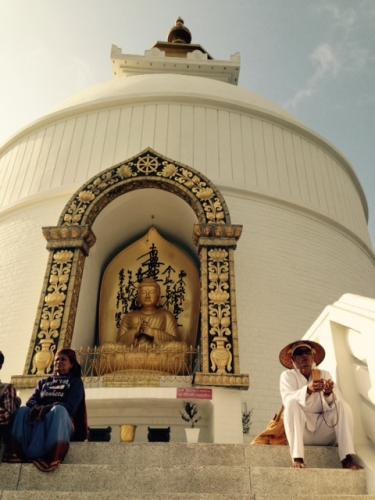 Peace Tower Stupa
Peace Tower Stupa
Back in the tourist community of Pokhara Sunday morning we went para-sailing!!! I put it down to peer pressure (teasing my younger trip mates), but I jumped off the mountain and it was amazing. I'd even do it again!
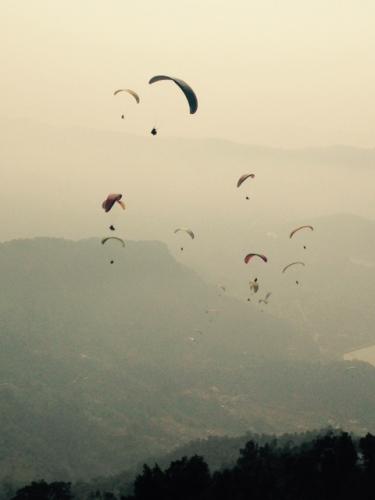 Para-sailing
Para-sailing
Our respite was quick and we returned Sunday afternoon back to the big city rush and noise and traffic, and a renewed focus on our mandates.
Last night the staff here at the Mayur guest house had a bbq and singsong out on the patio, and invited us to join in. A lovely group of people, this is a such a safe and friendly country! Everyone asks where you are from...why you are here, how long you will stay and what you think of Nepal. It's easy to give glowing responses!
 Singing on the patio
Singing on the patio
Day time weather is still around 18 degrees in the sun but inside the buildings it feels more like 15, so you dress in layers and work in your coats. I haven't needed gloves in the office yet, as I share a desk with my counterpart and he has the sunny corner of the building. We also share an internet cable and as mentioned, with load share, power can be limited. Monday and Tuesday there is no power in the office most of the day (10 am – 3 pm) so it's best to arrive with the laptop charged and prepare to switch to a notebook! At night I think it's still about 8 degrees out, at least according to the Weather Network. Frankly, it's warmer outside than in, at night and early morning.
I’m getting busy with work now with 2 workshops and 2 board meetings in the next week, handouts developed and being translated, PowerPoints printed. (One training is during load shed, so there will be no projector. Showing the PowerPoint on my laptop with paper copies will suffice.)
I had some time to bond with the ladies in the office here, Sarala and Bhawani. Nepalis love to have their pictures taken and we snapped some selfies. I was also given a tika, as a married lady, though I'm not sure if the size of the dot is related to caste.
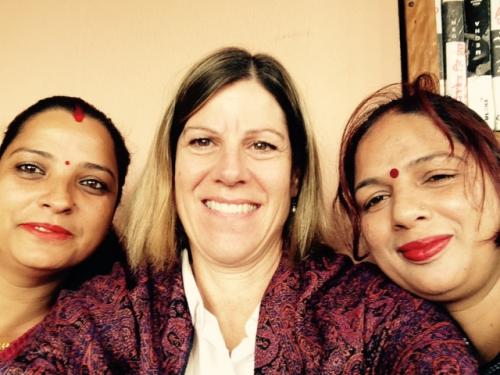 Selfie with Sarala and Bhawani
Selfie with Sarala and Bhawani
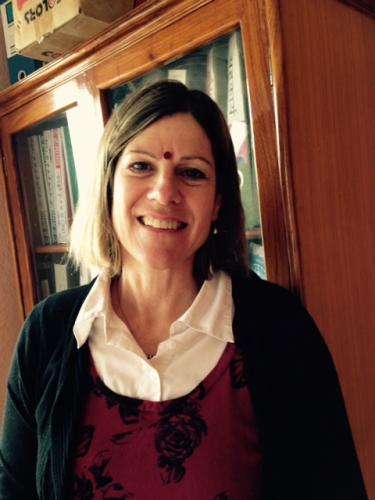 My tika
My tika
Some of the stores are decorating for Christmas here. A large tree just popped up outside the Bhat Bhateni, the department store down the street. Most of the population of course are Buddhist or Hindu, and there are either religious based or caste based festivals almost every weekend.
One amazing reminder of Christmas at home is that poinsettias grow wild here. I've counted about 6 varieties, and they are often 15 feet tall bushes! Some are double flowered, some more like a pom pom. Only 1 yellow (white) variety has been spotted, cultivated at the guest house we stayed at in Pokhara. Pretty cool!
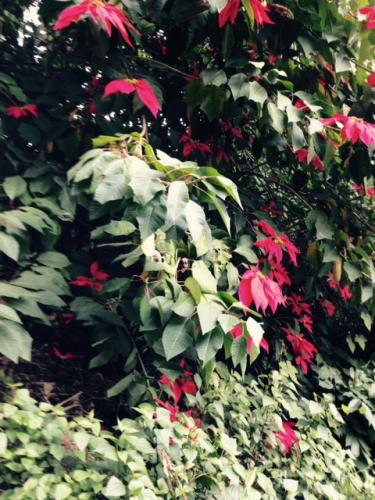 Poinsettia bush
Poinsettia bush
Working girl
Working in offices here can be challenging, when load shedding (power outs) rotate daily and there is no back-up generator. Wireless internet is not everywhere, and in my office at CDCAN we share an internet cord.
That said, much progress has been made! I will make presentations at two Board meetings over the next two weeks, as well as deliver an in house workshop on grant proposal writing. In addition, I will co-present a workshop on grant proposal writing tips to the CECI staff and partners. Much material to build and get translated!
This week my office counterpart, Kabiraj Humagain and I travelled to visit two dairy milk collection centers and met with the local District Milk Producers Cooperative Union (DMPCU) executives. The comparative analysis resulting from these site visits, one to an advanced Collection Center, and the other to a collection center that has greater geographical and infrastructure challenges, I will be able to better understand and assist with the fund proposals needed for the dairy industry here.
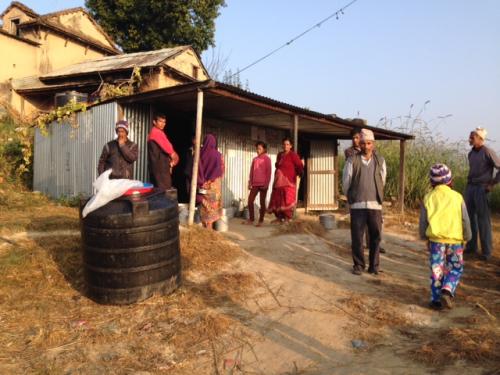
Travel is not easy over distances of 20 – 30 km into the hills, but the vistas – wow! Amazing! Here are some photos that I hope will show the terraces of farming.
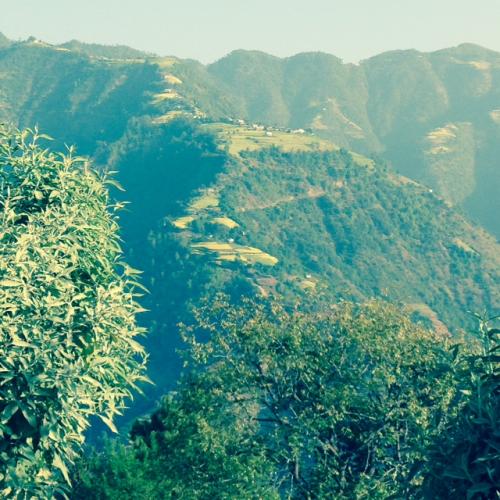 Road to Bagdevi
Road to Bagdevi
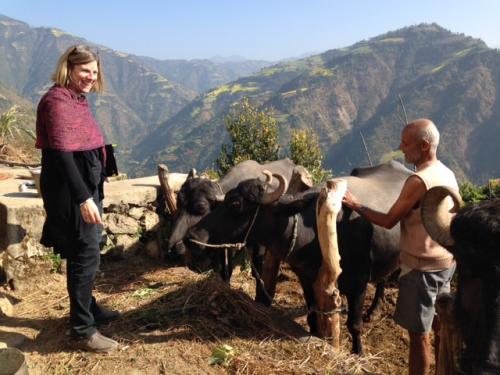
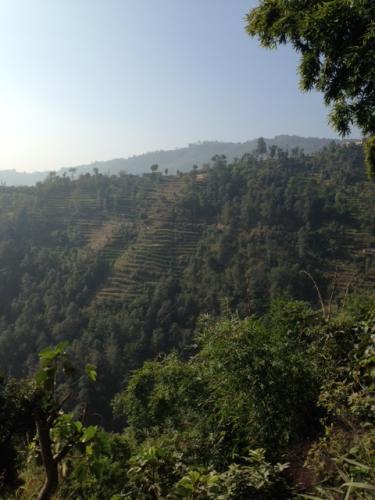
I was also formally welcomed to the CDCAN office by the Chair of our Board, Mr. Narayn Parasad Devkota, with a welcome ceremony – given a welcome scarf and “tika”, the red forehead powder, worn by many for good luck.
Today, Friday December 5, is International Volunteer Day, and our group is meeting at the Hotel Himalaya, Kupondole with other volunteer programs, from Australia, Japan, Korea, the UN, and the Peace Corps, to make presentations about our volunteerism experience and what our roles are in Nepal.
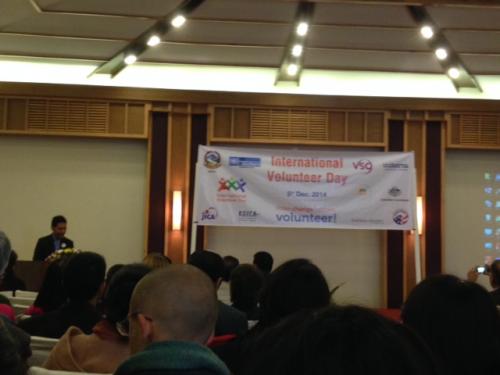
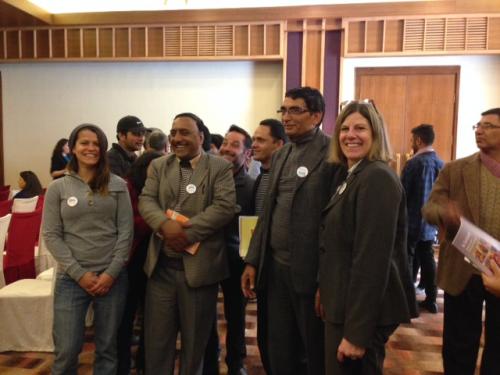
This evening is an additional presentation and reception, hosted by CECI here. Tonight will be a quiz show activity – wish me luck!
Dinner with the Ambassador
WUSC dinner with the Canadian Ambassador to Zimbabwe, Her Excellency Lisa Staedelbauer (far right) or Lisa. She was lovely and definitely didn't stand on ceremony.
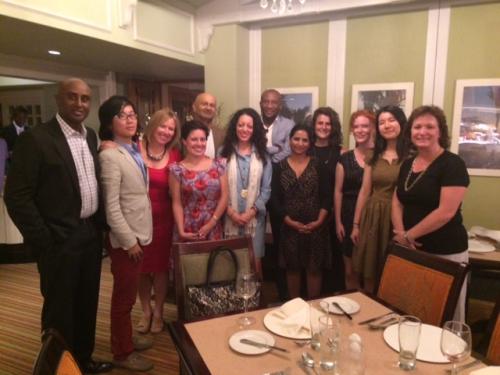
She had an interesting insider perspective on Zimbabwe having lived there for a number of years. We also remarked on the mosaic of Canadians at the dinner. Pretty diverse and from all corners of the country. It was a nice opportunity to connect with the others and it was a fun night out. Thank you Canadian taxpayers for treating us!
Only one week left. Time is flying by.
Connections - updated with photo
I'm having an amazing time. I met up with Saveena, a fellow U of G Leave for Change participant, for dinner her second night. She was delayed on her flight out the next day so we reconnected again the following morning at the airport when she eventually made her way to her mandate in the north. I think she spent about 12 hours at the airport trying to get out the previous day. Air Botswana was in a bit of a mess recovering from technical issues and a big storm that grounded all planes the evening before.
I was delayed for 6 hours but eventually reached Cape Town and had a wonderful time with my nieces. I had a very productive time at the airport where I met a few other WUSC and Leave for Change folks that were also heading away for the weekend. I also met a Canadian doing a postdoc in Pretoria who knows Jacqueline Murray from UBC, was on the WUSC board with David Hornsby, one of our students now teaching at Wits University in Johannesburg and, after a little more conversation, we discovered we also went to the same high school in Vancouver! Again, I need to remark its a very small world.
I completed my 2-hour training on communications, team building and conflict resolution today (Monday) at Stepping Stones. Thanks to Linda Watt for her support developing the training session. It all went well.
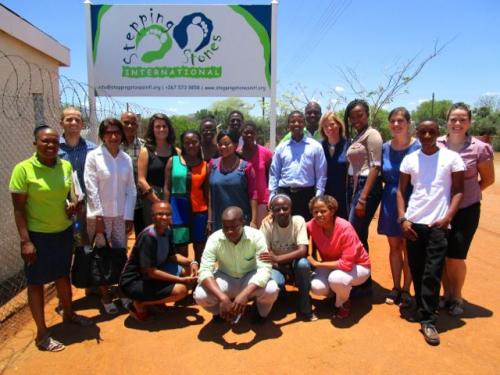
The time is going so fast. I probably could have done 5 weeks but my job and children might have found that too long. For me though, it's flying by.
Building upon foundations
What a week!
I worked in the CECI office a couple of days on my “surprise” additional training session and again today, Sunday. Fortunately, another long term volunteer is helping me with that training. In building the session tools, I’m actually getting a jump start on materials that will be useful for my mandate with the Central Dairy Cooperative Association of Nepal.
Friday was busy with meeting my partner organizations: first we travelled across town to meet the leadership of the Central Dairy Cooperative Association of Nepal (CDCAN), the national umbrella association for dairy farming where I will spend most of my time. Then we returned to the CECI office area for my welcome lunch (which I missed, however there was still some food, at Maple once again; I remembered the "note to self" - do not eat the hot relish!).
In the afternoon we travelled further afield to Lalitpur to meet the leaders of the Lalitpur District Milk Producers Cooperative Union, which is supported by the group I met in the morning. It is the oddest thing to meet with people when you have removed your shoes to enter the offices, but everyone keeps their winter coats on, as it's colder inside than outside!
These associations have a long list of requests for assistance, but together, the CECI Program Coordinator, Sagun, and I narrowed my mandate down to several items, including 2 training sessions; one for those at the CDCAN office level and another to include appropriate staff from both associations and appropriate NGO members. I will likely also be meeting with government officials, to "test the waters" for seed funding.
I should note that a number of the U of G personnel who have volunteered in Nepal have been involved with the Dairy programs here. I’m so fortunate to have input and access to past reports from Mary, Mandy and Looknauth, which have provided me not only supportive materials to build upon for my mandate, but also many details, names and suggestions so that, upon arriving I felt like I already knew many of the staff and volunteers working here.
Meanwhile, Saturday was a tour of the city. We began with visiting the Boudhanath stupa at Boudha. We also toured the Hindu temples at Pashupatinath and finally temples at Patan Square – where there was a World Peace rally going on. The buildings, statues, temples and stupas are amazing!! At Boudha, the peacefulness was palpable as devotees walked around the stupa, clockwise, many slowing to spin the prayer wheels. Prayer flags flap in the breeze – they must be hung outside, so that the prayers and blessings can be blown to others and peace spread on the wind.
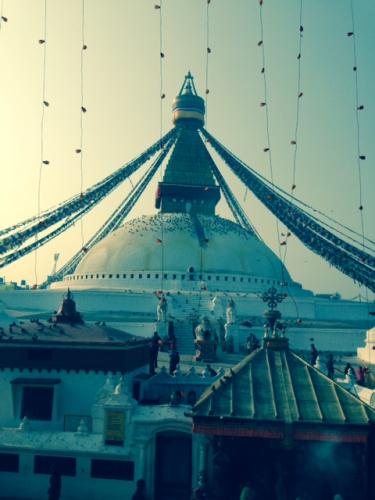 Boudha
Boudha
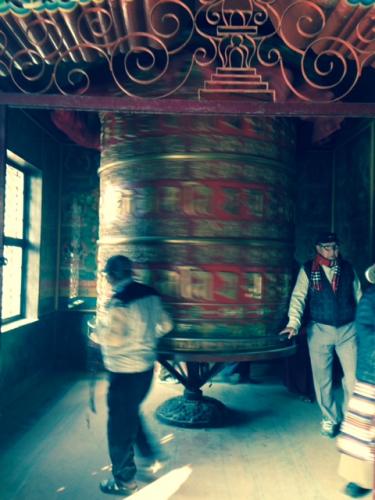 Spinning the prayer wheels at Budha
Spinning the prayer wheels at Budha
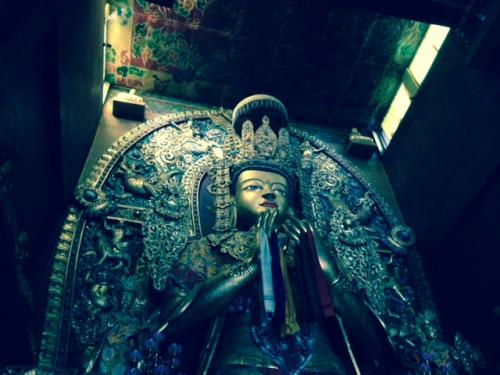 Buddha statue in temple at Boudha
Buddha statue in temple at Boudha
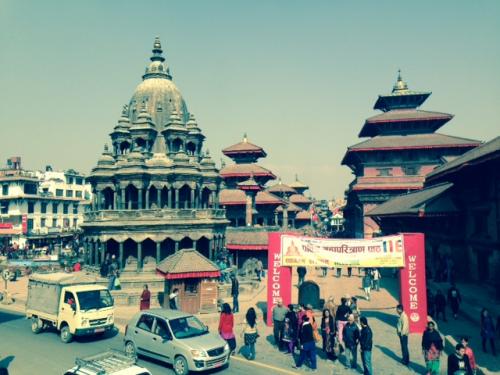 World Peace Rally at Patan Square
World Peace Rally at Patan Square
At the Hindu temple, animals are often set free and non-Hindus may not enter. There were monkeys, goats and bulls…freely walking about, eating grain put out for them. A young jersey type bull (with horns) walked right behind me, while others lazed in the sun.
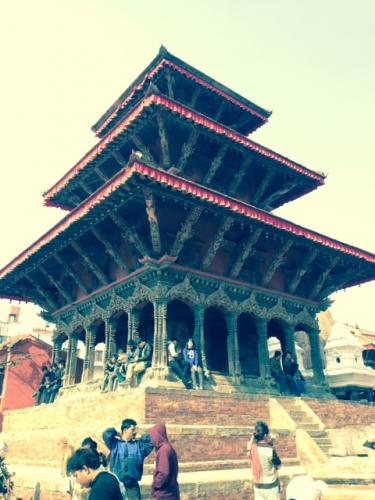 Hindu Temple in Pashupatinath
Hindu Temple in Pashupatinath
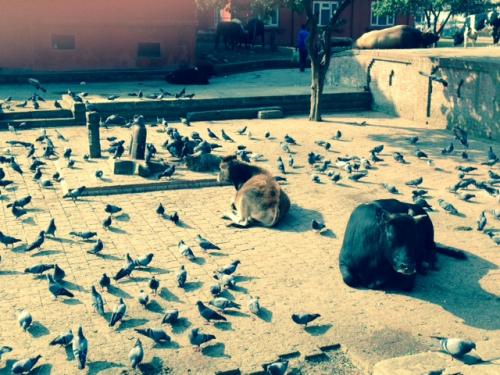 Bulls at the temple
Bulls at the temple
Our tour also took us to the burial crematorium at the river. What a humbling sight, to bear witness to the end of life and the acceptance of the circle of life here. And adjacent to the area, are the ever present souvenir tables selling statues made of stone, clay and brass, and jewellery.
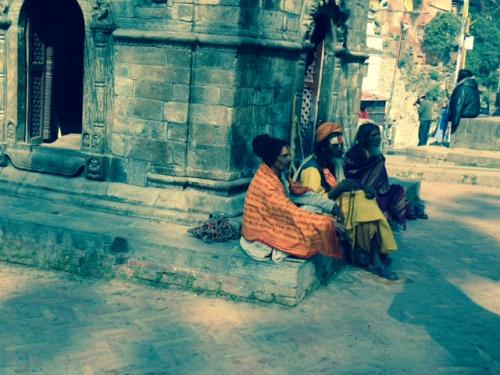 Holy men, near the crematorium
Holy men, near the crematorium
Next we were headed to the Fair Trade Christmas Bazaar - some of the volunteers are assisting with the Fair Trade Group or other partner associations, such as the Women's Entrepreneur Association of Nepal, where Dana, a volunteer from UBC is posted. It was crowded with shoppers and supportive followers.
Leaving there, it should be noted: everywhere you go, car, truck and motorbike horns beep incessantly to warn pedestrians and drivers alike; pedestrians walk on sidewalks, roads and in the gutter. Some locations are so crowded it's a miracle that no one is injured in traffic.
Exotic places
Flying into Doha, Qatar, I was amazed to see the landscape – light brown sand as far as the eye can see, dotted with sometimes barely discernable light brown buildings. Transferring at the airport was straightforward to the final plane, though I wished I had time to shop – or at least gaze upon the designer name products and fare available in the boutiques. There is the most interesting statue in the airport – a huge teddy bear, complete with button eyes - which is rather surprising at 23 feet tall and weighing in at 35,000 pounds! Reported to have been bought for $6.8 million by a member of Qatar’s royal family, this bear was previously displayed in front of the Seagram Building on New York’s Park Avenue and auctioned off at Christie’s New York.
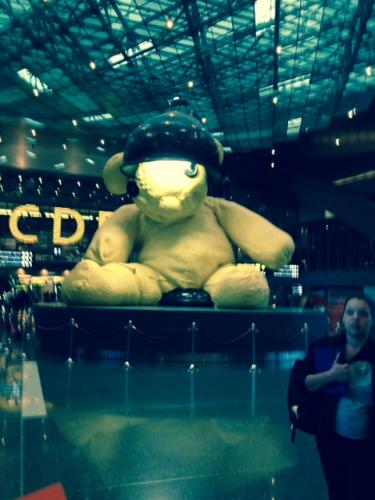
During the next leg, from Doha to Kathmandu, I was seated with an older lady, Tara, who had lived in the US for years, but now has retired back in Kathmandu. Her 3 kids, one with a grand kiddie, were all in the States, where she had been visiting. We got to chatting about the CECI program and Leave for Change and it turns out that the CECI office was in her neighbourhood. In fact, if I was in the area of Mike’s Breakfast (a well-known restaurant) I could ask for her, as she was in there all the time. We exchanged emails and went on our way.
Visible from the plane was a landscape that first resembled dry brown lowland with an occasional wandering road. Later the land appeared as a giant sandbox, with ridges and dunes, some steep cliffs, shaped roughly in large square or rectangular patterns as if by children at a beach. Closer to Kathmandu, a line of snow-capped mountains was visible past clouds on the horizon – majestic and remote, the snowy peaks presented a chilling reminder of winter for this Canadian! Below the mountainous area were wide dry river beds, tangled paths that the water must follow during monsoon season. I said I was not going climbing, but I may take a flight to Pokara, which is the “Lake Louise” of Nepal, and the flight promises great views of the mountains too.

Escaping from the plane into the Kathmandu airport, my traveling partner, Aisha from the Association of Universities and Colleges of Canada, and I found the lines for Tourist Visas short, though the lines for free Visas (except Indian) was where most travelers went and extended quite long; still though nothing in comparison to the lineups at Pearson when returning from international vacations...so maybe we were just lucky!
Outside the airport, the street area was lined with drivers with names on signs meeting the arrivals. It was hard to know if there were more crowds than usual, though security screening was tight; it seems that the South Asian Association for Regional Cooperation (SAARC) Summit is occurring here and many Asian country leaders were arriving also. In fact, the government issued an order to reduce traffic in the area prior to the Summit: cars with odd license plates could drive on odd days, and even numbered plates on even days!
In addition, the days of the actual Summit (Wednesday and Thursday November 26 and 27) have been declared national holidays! The theme for the 18th SAARC Summit is "Deeper Integration for Peace and Prosperity". Attendees include presidents or prime ministers from Afghanistan, Bangladesh, Bhutan, India, Maldives, Pakistan, Sri Lanka and of course, Nepal. While I didn’t see any of them, the arrival of these heads of state has affected my visit, as the Central Dairy Cooperative Association of Nepal (CDCAN) office where I will be working, is closed until Friday and so my meeting with the partner association and CECI program officer has been delayed until then. Never mind, as I was given an idea of their needs to start working with. Oh, and as a special surprise project, I’ve been given the opportunity to deliver a training session on proposal writing to all the volunteers working at the CECI offices, also!
Back to my meeting with Tara on the flight over – as our car arrived at Mayur House, a motel where we will be staying, Tara’s arrived at the same time. She and her husband, a doctor, live next door! In a city with a population in the millions, what chance is that - it is truly a small world! In true Nepali hospitality I’ve been invited to brunch in the adjoining courtyard, on Sunday if I’m not working, where eggs and tea are complementary and everyone brings something.
Traffic here includes a flurry of scooters, cars and vans which hurtle down roads, treating the central lines as mere guidelines, and moving amongst each other in a madly unchoreographed dance. Pedestrians, dogs and sometimes cattle, walk in the road often, stepping up the super high curbs (designed to handle the onslaught of monsoon weather in summer) when the tooting of horns announces oncoming vehicles…which is continual! The streets are lined with shops, dusty and crowded with funny 3 wheeled vehicles called tuk tuks, scooters and cars; local buses get packed to a point that is well beyond the comfort of personal space that we Canadians may be used to! Dogs are standing or curled up asleep all over the place, some with evidence of past litters, all are rough looking mixes, and not a one I can pet! I’m told that many street dogs were culled in the past so there are fewer than there were.

The first day of orientation was very welcoming: we were toured through the offices and introduced to several Canadian volunteers – all longer term (5-8 months) and some University interns here for a school year; we reviewed general information and were treated to a welcome lunch for 3 newly arrived volunteers from Australia at a local eatery – the Maple restaurant, which served up delicious curry dishes, potato paneer, fried chicken and some cabbage kimchi garnish (which, it turns out, was not best consumed on its own, as a mouthful!)
Today was another day of orientation – a history lesson on the political atmosphere in Nepal, and a discussion on possible "bandhs" or strikes. Travel plans are simply adjusted if road blockages occur, and life in Nepal – at least in Kathmandu – continues.
End of Week One
Has it really only been a few days? What an amazing first week.
I spent one day at WUSC for orientation and cultural training and my second day with Lisa, the executive director and founder of Stepping Stones at her home/office.
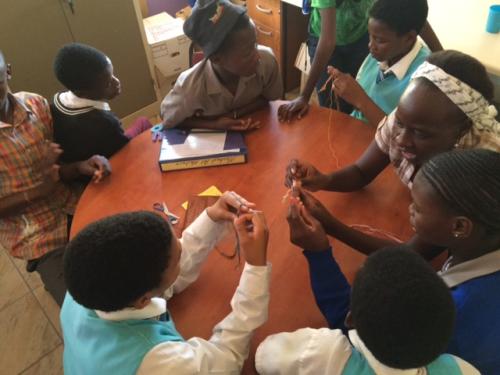
The last two days I have spent at Stepping Stones interviewing the staff as my mandate is to provide support with their internal communications, a most impressive team. I also had the opportunity to sit in on some of the sessions with the kids and my favorite so far has been the group assignment to develop a dance routine. They had to support each other to bring everyone up to the same standard. Not only was the dancing and singing fabulous but the laughter and encouragement they gave each other was mesmerizing. It was a high energy and happy room of children being children. I couldn’t believe these were the same kids described as previously without hope.
What an incredible place Stepping Stone is.
Leaving winter behind...
While the weather outside in Southwestern Ontario is frightful, I'm packing and repacking for the different weather that is winter in Nepal, including hot water bottles, multiple layers of clothing and fingerless gloves for office work!
The adventure starts early this Sunday November 23, with travels through Philadelphia, and Doha, Qatar to Kathmandu, exotic names and places, mostly!
I've been fortunate in having a lot of support from a number of past volunteers, and even been in contact with a few who are still there. Hopefully I will be able to pick up and add to the work done by many others.
The long haul
I left Toronto at midnight Saturday and I arrived in Gaborone noon Monday, November 17 feeling surprisingly bright. I had time in Heathrow for a nap, do a few emails and stretch my legs. I also had a few hours in Johannesburg which was surprisingly cool - only 11 degrees. I discovered later that my brother-in-law was in the airport at the exact same time. Small world. Too bad we didn’t bump into each other. I even saw the line for his flight to Malawi but of course I wasn’t expecting to see anyone I knew.
Botswana is a good deal warmer at 22 degrees but still cooler than I anticipated and with a breeze. All my agonising over what to bring seems to have worked out. I think the idea of light layers will probably serve me well.
I was met at the airport by Mmapaseke who drove me to the home where I am staying in Gaborone. The homeowner KT is away on business, home tomorrow, so I am on my own tonight. I was trained well by Sthabiso, who works here, on how to open the electric gate, all the door locks, where the light switches are and I even managed to walk to the Spar (local grocery store) to buy a few supplies and more importantly find my way back. I feel very welcome and comfortable.
I am very thankful to have Stephanie’s report to read from her work here this past summer. There is so much information to digest.
I met with Chile from WUSC for dinner and below is what I learned about Botswana. There was probably more but jet lag then set in.
- The three main industries are mining, tourism and farming (primarily cattle) and though the GDP appears high much of this wealth doesn’t reach individuals. These industries either rely heavily on technology so employ few or wages are low.
- It's tough to hold on to international funding as the country, on the surface, appears wealthy
- Infrastructure in country excellent but 80% of wealth held by 20% of the pople
- HIV and AIDS is a major issue. The government invested heavily in treating (all drugs are free) but there is still much to be done in changing behaviour to reduce occurence.
- Botswanans do not tend to immigrate to seek employment. If they leave to study almost all return (maybe 95%).
- Crime in the country is relatively low – policemen don’t carry guns – capital punishment perhaps deters immigrant crime
- Botswana is one of the only African countries that has had no political strife, civil war, etc. It's very stable.
- Gained independence in 1966 and was a very poor country but after indpendence diamonds were discovered which led to very rapid growth and wealth.
- The government invested in education (which was previously nonexistent), health and infrastructure but rapid growth together with rapid spread of HIV & AIDS has contributed to a break down of the family structure.


